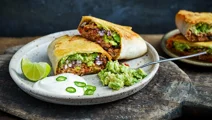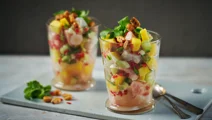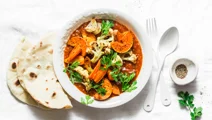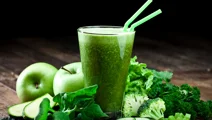Fruit leather
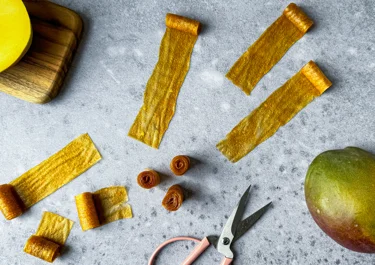
Discover the joy of snacking with our wholesome fruit leather recipe, a delightful blend of natural flavours and simple ingredients. We turn ripe mangoes into a chewy treat with a hint of lemon and a touch of agave syrup. Celebrating simplicity, this homemade snack is free from artificial additives, capturing the essence of fruit at its best. Perfect for snacking on the go, our fruit leather is a feel-good treat that brings a burst of tropical flavour to your day.
Ingredients
|
400 g
Mangos (fresh or frozen)
|
|
|---|---|
|
50 g
Water
|
|
|
3 tbsp
Agave syrup
|
|
|
1 tbsp
Lemon juice
|
Instructions
Questions about fruit leather
Create a batch of chewy fruit leather with our straightforward guide. We've answered some common questions to help you perfect this naturally sweet snack. Find out how to use various fruits, keep your treats fresh, and add creative twists for extra flavour.
What if my fruit leather is too sticky or not fully dehydrated?
If your fruit leather turns out too sticky or isn't dried enough, it needs more time to dehydrate. Return it to the oven and continue to dry in 30–60-minute intervals. Keep checking the texture until it's not sticky and feels chewy. To avoid over-drying, which can make the leather brittle and prone to cracking, monitor it closely. For the best results, dehydrate at the oven's lowest temperature, between 54°C and 88°C. If you're using a dehydrator, set it to around 57°C. If the leather gets too dry and hard, leaving it out at room temperature can help it regain flexibility.
Are there any creative flavour combinations I can try?
Yes, there are several exciting options to try. Consider adding a twist by incorporating other tropical fruits like pineapple, papaya or raspberries alongside mango, for a multi-layered tropical medley. For a refreshing tang, swap the lemon juice with lime juice or even a splash of orange juice. For a sophisticated touch, sprinkle coconut flakes or finely chopped nuts onto the mixture before baking for added texture and flavour complexity. These variations not only enhance the fruity essence but also offer delightful surprises with each chewy bite, making snacking a true pleasure anytime, anywhere.
Can I add other sweeteners to my fruit leather?
Absolutely! You can substitute agave syrup with honey, maple syrup, or even brown rice syrup to tailor the sweetness to your preference. Each sweetener brings its own unique flavour profile, enhancing the natural sweetness of the mango and complementing the hint of lemon juice. Adjust the amount according to taste, ensuring the sweetness balances well with the tangy fruit flavours. Whether you prefer the floral notes of honey or the deep richness of maple syrup, these alternatives offer a chance to personalise your homemade fruit leather while maintaining its natural appeal.
Spread the puree evenly for perfect fruit leather
To get fruit leather that dries well and has a chewy texture, spread the puree evenly on the baking sheet. Start with about 6 mm thickness at the edges and go thinner toward the centre, around 3 mm. This stops the edges from drying too fast and getting brittle, while the centre dries just right, not too sticky. If your puree is thin or you've spread it too thick, it might need to dry for up to 10 hours.
Preventing overcooking
Check the texture of your fruit leather after three hours in the oven to avoid overcooking. It's done when it feels dry but still bends easily. Overcooked leather becomes too hard to roll. Set a timer for four hours, and if needed, continue drying in shorter bursts of 30-60 minutes. If it does overcook, leaving it out at room temperature can make it more flexible. If the first batch isn't perfect, don't worry. You can always refine your method next time!
Storing for freshness
For fresh homemade fruit leather, wrap it in plastic and put it in an airtight container in a cool, dry spot like the pantry. It will stay good for up to two weeks. For longer storage, place the container in the refrigerator for up to six months, or freeze it: if wrapped well and placed in a freezer bag, it can last up to a year . Before you eat fruit leather from the fridge or freezer, let it thaw at room temperature.
Can I use different fruits as a base for this recipe?
Yes! You can make fruit leather with many different fruits. Our recipe features mango, but strawberries, raspberries, or any seasonal fruits are great too. You'll need about 400 grams, or two to three cups of pureed fruit, no matter which type you choose.
Think about the sweetness of the fruits you pick, as it will affect your fruit leather's taste. Tart fruits may need a little more agave syrup or honey for sweetness.
If you're using frozen fruits, make sure they're fully thawed and drained before pureeing. This recipe's flexibility lets you use the freshest fruits for a tasty, homemade snack.
Serving and presentation tips
Serving fruit leather with visual appeal is as important as its taste. Our recipe recommends a rolled presentation, but feel free to shape your fruit leather with cookie cutters into stars, hearts, or animals. These shapes are great for platters or special treats in lunchboxes. Playful shapes on a simple background make snack time interactive and attractive.
Enhance the overall flavour by pairing fruit leather with foods that complement it. Serve it with a bowl of tangy skyr, creamy mango nice cream, fresh berry fruit salad or a crunchy mix of granola for a satisfying contrast in textures. This creates a balanced snack and introduces a range of flavours that blend well. You can also chop the fruit leather into small pieces to sprinkle over salads, oatmeal bakes or sweet chia puddings, adding sweetness and chewiness.
Use lemon juice to preserve colour
The tablespoon of lemon juice not only adds a zesty flavour to this recipe, but it also keeps the colour bright. Lemon juice naturally prevents the browning of lighter-coloured fruit leathers. While lime juice is a possible substitute, it may not preserve the colour as effectively. For a sweeter taste, orange juice is an option, but it is less effective for colour preservation. Choose either fresh or bottled lemon juice to enhance the taste and keep the colours vibrant.
Dehydration techniques for consistency
To make perfect fruit leather, proper dehydration is key. Spreading the mixture evenly is the first step. Next, control the oven temperature carefully. If your oven has a convection setting, use it to circulate air and dry the leather evenly. If not, open the oven door every now and then to let moisture out and keep the heat from getting too high. Also consider rotating the baking sheet halfway through to ensure even drying.
Finally, consider the humidity in your area. It can change the drying time. High humidity may mean longer drying times, while a dry climate could shorten it. Watch your fruit leather as it dries to make sure it comes out with a consistent texture and is enjoyable to eat.





